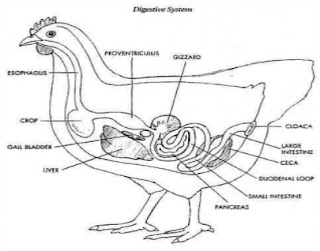They are then carried to their target systems and organs to carry out their task (growth, ovulation, oviposition, molting, etc).When these get out of balance, the bird’s body cannot function properly and hence performance will suffer, in some cases even to death.
Endocrine system of the chicken
- Pituitary gland or hypophysis
- Hypothalamus
- Adrenal gland
- Thyroid gland
- Parathyroid glands
- Ultimobranchial bodies
- Pineal body
- Islets of langerhans
- Gonads
Pituitary gland or hypophysis
- Called as master gland (controlling gland) because many of the compounds produced, target other similar glands to trigger them to produce their compounds, thus, influence the functioning of a particular system or organ.
- The pituitary gland is a pea-sized gland located at the base of the brain and is well protected by the surrounding skull bones.
- It consists of two parts:
- Anterior pituitary
- Posterior pituitary
Anterior Pituitary
- The anterior pituitary gland is stimulated by special releasing factors from the hypothalamus of the brain to produce and release a number of hormone.
- These hormones :
- Thyroid Stimulating Hormone - stimulates the thyroid gland.
- Adrenocorticotrophic Hormone - stimulates the adrenal cortex.
- Sex hormones - stimulates the sex glands:
- Luteinising Hormone : oviposition, testis growth
- Follicle Stimulating Hormone : yolk development, spermatogenesis
- Melanin Stimulating Hormone - function in birds is unknown.
- Natural Growth Hormone (Somatotropic Hormone) - stimulates growth of the animal.
 |
| Image Fowl Systems |
Posterior Pituitary
- Produces vasotocin and stores oxytocin that is produced by the hypothalamus.
- release of the yolk into the oviduct
- the actual laying of the egg or oviposition.
- The secretions produced or stored in the pituitary gland enter the blood stream and are then transported to the part of the body that they target.
Hypothalamus
- It is a major part of the brain located at its base and more or less centrally in the skull.
- Produces :
- Releasing factors that act as a control on the anterior pituitary gland
- Oxytocin that plays a part in the release of the yolk.
- The quantity of the releasing factors and oxytocin released is influenced by day length - the longer the day to 18 hours the
- greater the amount of these compounds released and the greater the effect on the target gland or function.
Adrenal gland
- Small glands approximately 9 mm long located anterior to or in front of the kidneys.
- There are two such glands, each associated with a particular kidney.
- Each gland consists of two different types of cells that form two distinct parts of the gland :
- adrenal cortex
- adrenal medulla
- The cortex produces three hormones:
- Corticosterone - carbohydrate and fat metabolism, breakdown of protein and important in the bird’s reaction to stress
- Aldosterone - retention of sodium
- 8-hydroxycorticosterone - function unknown
- The adrenal medulla produces two compounds:
- Norepinephrine - fat metabolism
- Epinephrine - control of blood pressure
Thyroid gland
- Consists of two reddish purple glands lying one on each side of the base of the neck.
- This gland produces two hormones:
- Thyroxine
>carbohydrate metabolism,
>promotes high blood sugar level,
>promotes growth
>involved in the moulting process
- Triiodothyronine
>involved in the moulting process
Parathyroid glands
- These are two small, round, yellowish-white glands located at the base of the thyroid glands at the base of the neck.
- They produce a hormone called parathormone.
- Parathormone reacts to low blood calcium levels and works to increase the amount of calcium in the blood.
Ultimobranchial bodies
- These are 1-3 mm long and located just posterior (behind) to the parathyroid glands.
- Produce a hormone called calcitonin that works to reduce the calcium level in the blood stream.
- Parathormone and calcitonin must be in balance if the calcium levels in the blood are to be in balance to requirements.
Islets of langerhans
- These are small clumps of special cells located in the pancreas, which sits in the duodenal loop of the small intestine.
- Produce two hormones:
>Glucagon - increases blood sugar and affects fatty acid levels
Gonads
- The sex organs of males (testis) and females (ovarium) are called the gonads.
- Produce hormones called sex hormones :
>Testosterone.
>Progesterone.
- Both males and females produce and need all three hormones but in different amounts.
- When a male is castrated, the balance of the sex hormones is affected, leading to the bird taking on female characteristics.
- This means that a capon or castrated male will, over time, take on much of the appearance and behaviour of a female.
0 Response to "Regulasi Hormonal Endocrine Fowl Systems "
Post a Comment